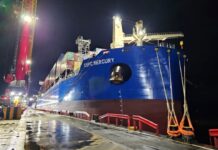
Google Cloud has announced the launch of Supply Chain Twin, a purpose-built industry solution that lets companies build a digital twin, a virtual representation of their physical supply chain, by orchestrating data from disparate sources to get a more complete view of suppliers, inventories, and other information.
In addition, the Supply Chain Pulse module can be used with Supply Chain Twin to provide real-time dashboards, advanced analytics, alerts on critical issues like potential disruptions, and collaboration in Google Workspace.
The majority of companies do not have complete visibility of their supply chains, resulting in retail stock outs, aging manufacturing inventory, or weather-related disruptions, according to Google, which said that in 2020, out-of-stock items alone cost the retail industry an estimated $1.14 trillion.
The past year-and-a-half of supply chain disruptions related to Covid-19 has further proven the need for more up-to-date insights into operations, inventory levels, and more, according to Google.
“Siloed and incomplete data is limiting the visibility companies have into their supply chains,” said Hans Thalbauer, Managing Director, Supply Chain & Logistics Solutions, Google Cloud. “The Supply Chain Twin enables customers to gain deeper insights into their operations, helping them optimize supply chain functions—from sourcing and planning, to distribution and logistics.”
With Supply Chain Twin, companies can bring together data from multiple sources, all while requiring less partner integration time than traditional Application Programming Interface (API)-based integration.
Data types supported in Supply Chain Twin include:
- Enterprise business systems: Better understand operations by integrating information such as locations, products, orders, and inventory from Enterprise resource planning (ERP) and other internal systems.
- Supplier and partner systems: Gain a more holistic view across businesses by integrating data from suppliers, such as stock and inventory levels, and partners, such as material transportation status.
- Public sources: Understand your supply chain in the context of the broader environment by connecting contextual data from public sources, such as weather, risk, or sustainability-related data, including public datasets from Google.
Google added that once customers are up-and-running on Supply Chain Twin, the Supply Chain Pulse module enables further visibility, simulations, and collaboration features:
- Real-time visibility and advanced analytics: Drill down into key operational metrics with executive performance dashboards that make it easier to view the status of the supply chain.
- Alert-driven event management and collaboration across teams: Set mobile alerts that trigger when key metrics reach user-defined thresholds, and build shared workflows that allow users to quickly collaborate in Google Workspace to resolve issues.
- Artificial Intelligence (AI)-driven optimisation and simulation: Trigger AI-driven algorithm recommendations to suggest tactical responses to changing events, flag more complex issues to the user, and simulate the impact of hypothetical situations.





